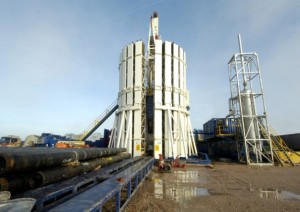
A fracking rig in Lancashire: fracked gas threatens to undermine the price solar operators can charge for electricity
A new wave of ‘unconventional gas’ in the UK (including fracking) is a direct threat to the roll-out of renewable energy in the UK.
Often touted as a ‘bridge’ between coal-based electricity generation and renewables, unconventional gas is in fact not only a menace to the environment, it also undermines the economic rationale of renewables. Senior Greenpeace sources state that the promise of UK unconventional gas is ‘driving a coach and horses through climate change legislation’.
The nature of this threat is financial. To understand it, solar provides an illuminating example:
As the price of solar tumbled in the last six months, Feed in Tariffs plummeted even faster. This increasingly forced solar operaters to ask for payment for the electricity they’ve generated (albeit still charging a cheaper rate than electricity from the grid). The cash from electricity sales topped up the subsidy.
Subsidies are predicted to continue to fall, so two or three years down the line subsidies are expected to approach zero. This is known as grid parity: the point solar at which will be entirely reliant on electricity sales for revenue.
And this is where unconventional gas enters the picture. In the US fracked gas has forced down the price of electricity by as much as 50%. If this were to be repeated in the UK solar companies will be forced charge less. And the less they charge, the further away the point of a subsidy-free viability.
Unconventional gas promises huge amounts of new, UK-based natural gas. New power stations are planned, each of which is built to last 25 years. Increasing the amount of gas available drives down prices, which in turn drives down the revenue that renewables can achieve through electricity sales.
To claim, therefore, that fracked gas will bridge between coal and renewables ignores a key impact of the rush towards ‘extreme energy‘: the money. From a financial point of view, a new supply of gas will delay the implementation of renewables, not facilitate it.
Trackbacks/Pingbacks